What's Next in the Evolution of the Mall Piercing?
With the death of Claire's looming, a number of emerging jewelry startups have some ideas.
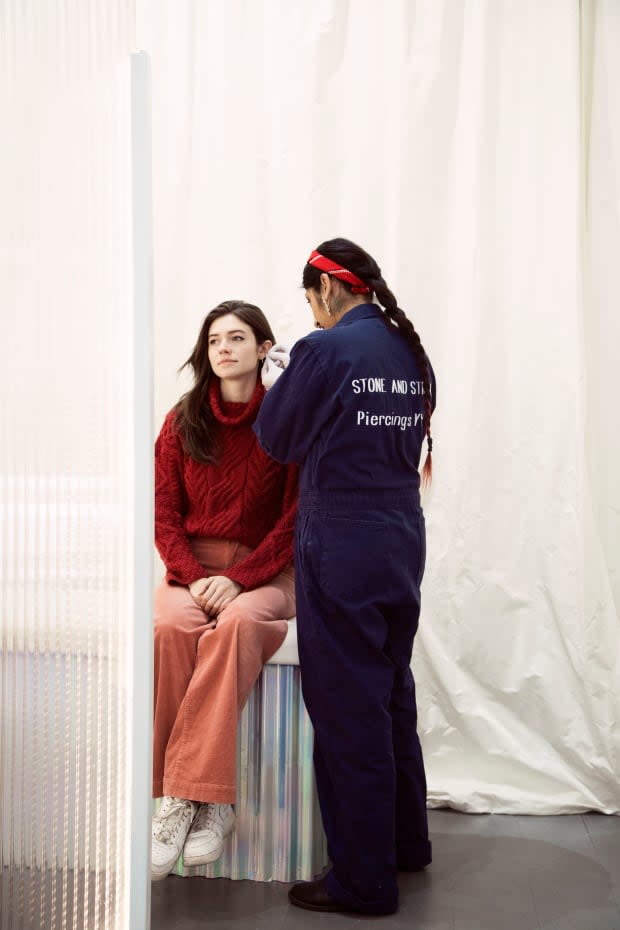
Like many tweens in the '90s and early 2000s, I got my ears pierced at Claire's, with a piercing gun, surrounded by piles of disorganized, cheap jewelry, body glitter and temporary tattoos with signs for various bogo-type promotions. That was when I learned that my ears are highly sensitive to metal, as they immediately got infected. I let the holes close up, never re-piercing them until age 24, at a hole-in-the-wall tattoo and piercing shop with questionable hygiene standards on St. Mark's Place in New York City. (I'm pretty sure my ears got infected then, too, but I stuck it out.)
Strangely, for many people, these are more or less the two best options out there for ear piercing: At the low end, there's the Claire's at your local mall, and at the...well, also low end, but for adults, there are tattoo shops. There are a few, more elevated exceptions, like, say, Maria Tash, an expensive jewelry and piercing shop in New York, or 108 Atelier, an exclusive, appointment-only piercing studio founded by piercer-to-the-stars J. Colby Smith, with locations in Brooklyn and Los Angeles; but those types of experiences are only accessible for a select few in big cities.
And today, as malls struggle with major declines in foot traffic, the Claire's at your local mall is an even less viable option: Last year, it joined fellow suburban mall stores like Payless and Wet Seal by filing for bankruptcy and announcing 92 store closures (after having already closed more than 100 in preceding years). Competitor Piercing Pagoda closed 24 locations last year, but did see a lift in sales at those that remained open.
But interest in piercing has not declined, with young people still looking forward to the milestone of their first piercing and adults increasingly interested in multiple piercings — so why do the options for getting them suck? Well, the startup world is starting to notice this too, it seems. And like so many sleepy industries that have lacked innovation and failed to adapt to changing consumer habits, disruption is coming, mainly from female founders.
Related Articles
How Maria Tash Went From Piercing Her Friends' Ears at Home to Launching a Global Jewelry Line
Thinking Like a Tech Company Spurred Fine Jewelry Brand Mejuri's Remarkable Growth
The Last Line Is Trying to Turn the Traditional Fine Jewelry Model on its Head
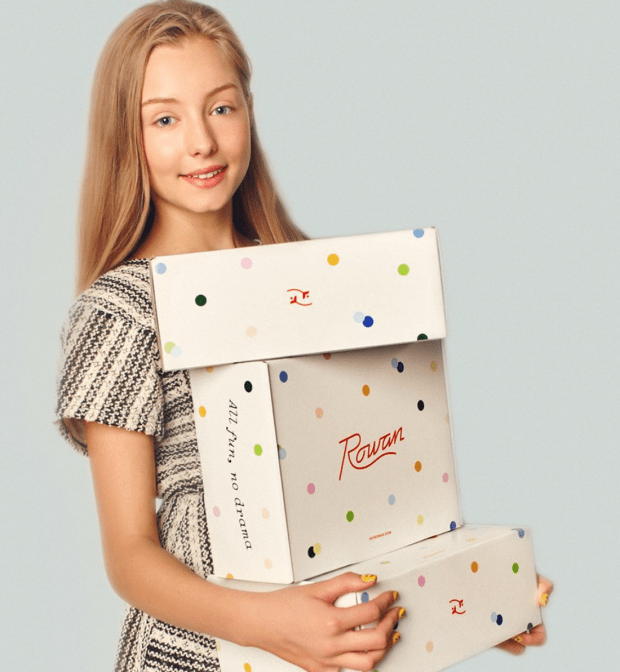
The premiere example, perhaps, is Rowan: The tween-focused, at-home piercing startup launched this year with $4 million in venture capital and a flurry of media coverage over the summer with each article declaring it to be "the next Claire's." And yes, the chain's shortcomings did inspire founder Louisa Schneider, alongside a convergence of other events and realizations.
Around five years ago, Schneider worked at a hedge fund where part of her job involved researching retailers that were paying rent at malls that weren't doing well. "One of them, that had virtually 100% overlap with every troubled mall in America, was Claire's," she explains. Around the same time, she took her pre-teen nieces to get their ears pierced at a location in a Cincinnati suburb (it was the only option) and called the experience "depressed."
"The Claire's was really not in good shape," she says. "When I thought about my own daughter, I wanted [a first piercing] experience that would be special for her." A couple of events — her husband ordering an on-demand at-home massage, attending a friend's son's bris — also got her thinking about intimate, at-home experiences. She also learned, from the many medical professionals in her family, that a lot of pediatric nurses end up performing ear piercings on young children.
With Rowan, trained and licensed local nurses perform every piercing, which are done with fine-quality jewelry (so no infections) made in Brooklyn and followed by thorough after-care instructions; customers can also subscribe to receive fun boxes each month containing new jewelry and other items for tweens like journals and stickers. There's also a newsletter that parents can subscribe to with topics around "how to best communicate and build confidence in your tween."
"We are very much trying to commemorate that first ear piercing for a young girl and her parents and be reachable not just to people living in urban exclusive areas that have piercing salons, but also to provide an experience that's very, very safe," says Schneider. Currently, Rowan is only available in New York, Connecticut, New Jersey and North Carolina, but Schneider says the company has already received inbound interest from about every state in the U.S. and plans to expand "thoughtfully."
"There's certainly a place for us to be what Claire's was from a digital standpoint and from a product standpoint, from an experience standpoint," says Schneider. "We're really trying to hold the hand of the parent and the girl and that's certainly not something that you get from a lot of the mall-based retailers, so that's something that really differentiates us."
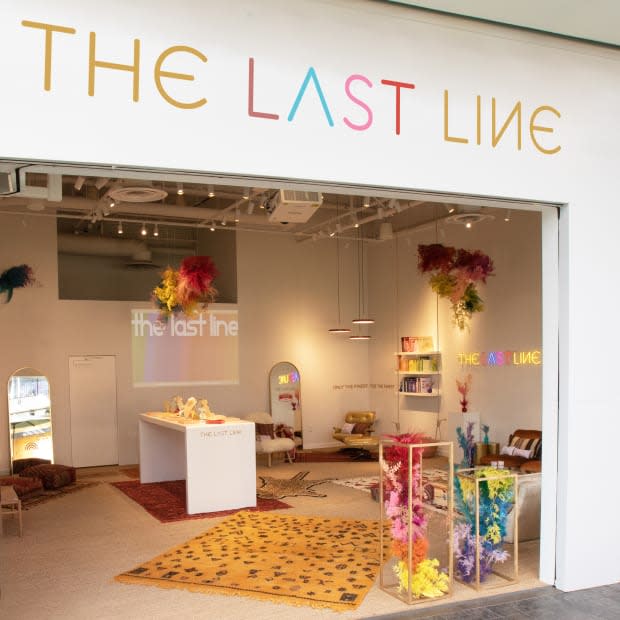
This is all wonderful for 10-year-olds and their families, but what about grown-ups?
For us, a group of direct-to-consumer, digitally native fine jewelry startups are increasingly incorporating piercing into their IRL experiences. (Don't call 'em stores.)
For the past couple of years, L.A.-based cool-girl jewelry brand The Last Line has hosted piercing parties for editors and influencers in L.A. and NYC. As adept at branding and events as they are at designing playful and distinctive fine jewelry, the parties have always been packed and well-documented on Instagram, prompting consumers to beg for an opportunity to partake. This month, they finally got that opportunity as The Last Line opened its first pop-up at Westfield Century City, which is, fittingly, probably the gold standard of what a successful mall looks like in 2019. One might even describe the space as luxurious.
Known for incorporating camp and nostalgia into her jewelry and events, Founder Shelley Sanders used the pop-up as an opportunity to play on the traditional mall piercing. "The Last Line rewrote the rules of fine jewelry and are now rewriting the rules of mall piercings," read the invitation for the pop-ups opening. "Customers will not have a dated mall piercing experience, but a luxury one."
"When we do things that are vintage or campy or referential of the '90s or children, we always do them with the idea of: It's a seventh-grade camp friendship bracelet, but make it for the woman who pays her own rent and bills and has her own job and loves luxury, so really elevating it," she explains. "Your options for piercings are a tattoo shop or a low-end experience in a mall. Those two experiences are incredibly different and it's like you have to choose quality over ease. It seems like the next thing we had to do was to really make that experience feel luxurious." The brand hopes to pop up in New York next, over the holidays.
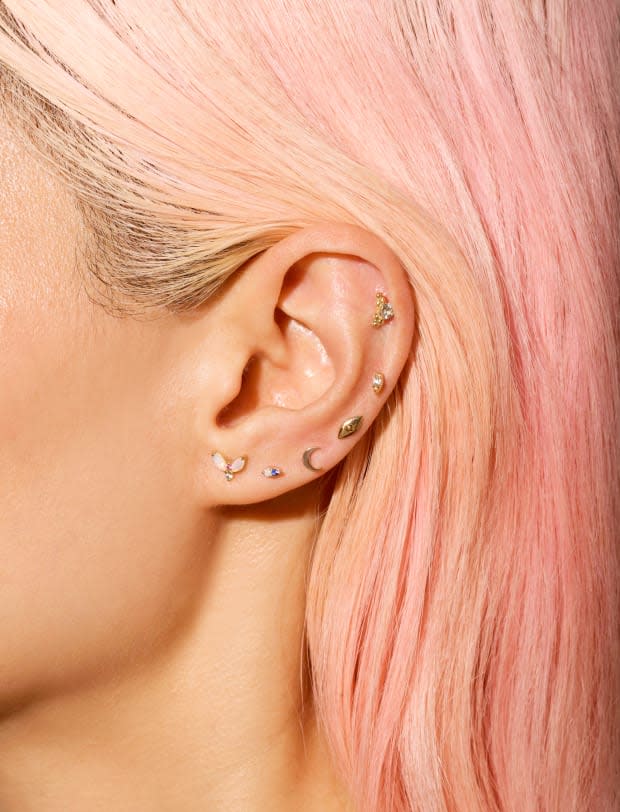
"WAY Better than Claire's," read the subject line of an email blast from Stone and Strand in 2017, announcing its piercing pop-up series, dubbed Piercings Y'all.
"We wanted more piercings but felt like our only options were to go to a place like a traditional mall jeweler like Piercing Pagoda and Claire's where they shoot with a gun versus going to tattoo parlors, so we felt like there was a white space we were seeing and we were in a great position to fill it as a jewelry manufacturer," explains Stone and Strand Founder Nadine McCarthy Kahane. "We're the first to combine the more accessible pricing that you can do as a direct-to-consumer business because we own the supply chain, alongside also offering a service at the very highest level possible in terms of piercing standards." This month, Stone and Strand expanded Piercings Y'all to include a line of high-quality threadless flat-back jewelry specifically designed for piercing.
The furthest along of these retailers is probably Mejuri, which has opened three permanent showrooms in Toronto, New York and, opening Sept. 21, L.A. Based on the success of monthly piercing parties in the first two locations, the company will open its first permanent piercing studio in L.A. with appointments available seven days a week.
"Piercing has been incredibly popular from the day we launched it — it's a fun experience, serving a market that wasn't previously seen (customers looking for styling, rather than the younger demographic who are getting their first piercing)," explains Founder Noura Sakkijha over email. "Over 2,000 people come in during our weekend pop-ups."
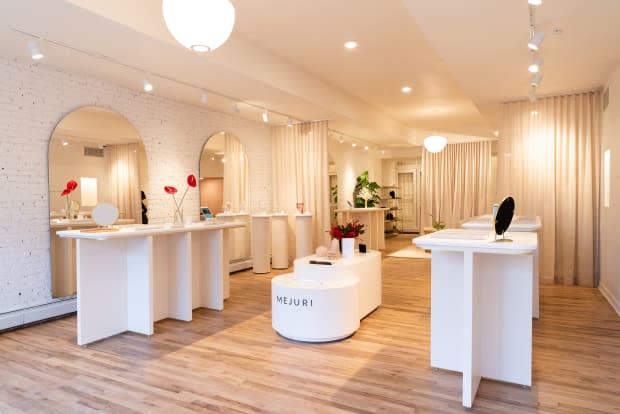
Among the advantages of going to one of these more elevated piercing experiences as opposed to a mall piercer only capable of sticking a gun into your ear lobe is that they take pride in being able to "style" your ear, taking into consideration factors like balance, placement and existing and future piercings, and suggesting the right jewelry, since it all lives in ones space. The above retailers all also emphasized their use of professional piercers who offer a clean, safe experience with sterile, one-time-use needles — and their desire to create a luxurious, serene, spa-like vibe. Pricing structures vary: At The Last Line pop-up, the price of the piercing is folded into the cost of the jewelry (studs can range between $150 and $750 depending on materials) along with a fee for converting the jewelry into a piercing piece. At Piercings Y'all, it's $15 for lobe, $25 for cartilage. At Mejuri events, piercings are complimentary, while the permanent L.A. shop will have an yet-to-be-determined nominal fee.
Of course, being online retailers, piercing is also a way for these companies to create meaningful brick-and-mortar experiences that will actually bring people in; if they just wanted to buy jewelry, they could do so online. It's also a clever revenue-driver separate from the piercing itself: The more piercings a customer has, the more jewelry they need. It can also help build brand awareness, especially with an independent brand like The Last Line setting up shop in one of L.A.'s biggest malls.
But each of the founders can attest that there is also just significant demand from consumers — children and adults alike — who want a fun, easy, special and safe piercing experience; so while each of them are in the early stages of incorporating piercing into their business models, the opportunity to expand in and outside of metropolitan cities is there. This is only the beginning.
Getting pierced as a tween remains a mainstream rite of passage, and for more and more people: "As we grow, we do want to serve everyone who wants our services and there are a lot of boys who do," says Schneider of Rowan. "This age group we're focused on is much less concerned about being perceived as very feminine or very masculine, but really just self expression."
And for adults, having multiple piercings is becoming increasingly accepted. "If you look at the tattoo industry, that reached the mainstream stage a little earlier than piercing did in its life cycle, so for me it's relevant comparison in that people still are super excited to get a tattoo," says McCarthy Kahane. "Piercing is set to become part of mainstream culture. It's here to stay."
Never miss the latest fashion industry news. Sign up for the Fashionista daily newsletter.
